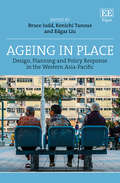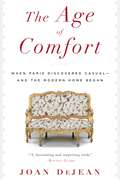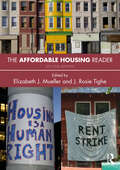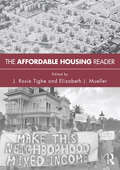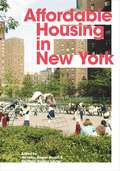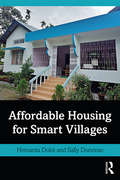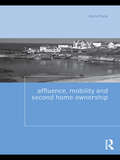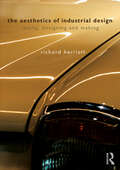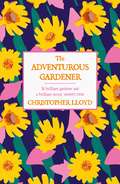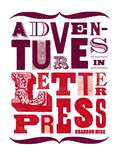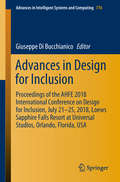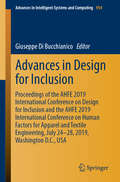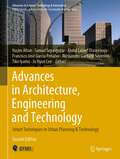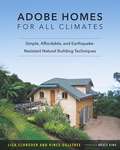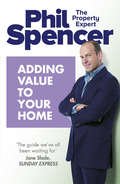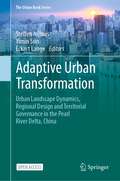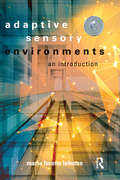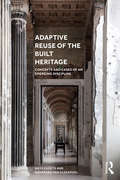- Table View
- List View
Ageing in Place: Design, Planning and Policy Response in the Western Asia-Pacific
Encouraging older people to age in place in their own homes is a common response internationally to the economic and social demands of population ageing. It is recognized that the nature of the built environment at various scales is critical to optimizing the social participation and wellbeing of older people and hence in facilitating ageing in place. This insightful book showcases a range of design, planning and policy responses to ageing populations from across the rapidly changing and dynamic Western Asia-Pacific region. Ageing in Place considers diverse cultural, political and environmental contexts and responses to show that regional governments, industries and communities can gain, as well as offer, important insights from their international counterparts. With significant changes in caring, family dynamics and the supporting roles of governments in both Eastern and Western societies, the chapters demonstrate a clear and increasingly convergent preference for and promotion of ageing in place and the need for collaborative efforts to facilitate this through policy and practice. The unique geographical focus and multi-disciplinary perspective of this book will greatly benefit academic researchers and students from a variety of backgrounds including architecture, urban planning, sociology and human geography. It also provides a unique entry point for practitioners seeking to understand the principles of design and practice for ageing in place in homes, neighbourhoods and care facilities.
The Age of Comfort: When Paris Discovered Casual--and the Modern Home Began
by Joan DeJeanToday, it is difficult to imagine a living room without a sofa. When the first sofas on record were delivered in seventeenth-century France, the result was a radical reinvention of interior space. Symptomatic of a new age of casualness and comfort, the sofa ushered in an era known as the golden age of conversation; as the first piece of furniture designed for two, it was also considered an invitation to seduction. With the sofa came many other changes in interior space we now take for granted: private bedrooms, bathrooms, and the original living rooms. None of this could have happened without a colorful cast of visionaries-legendary architects, the first interior designers, and the women who shaped the tastes of two successive kings of France: Louis XIV's mistress Madame de Maintenon and Louis XV's mistress Madame de Pompadour. Their revolutionary ideas would have a direct influence on realms outside the home, from clothing to literature and gender relations, changing the way people lived and related to one another for the foreseeable future.
The Affordable Housing Reader
by Elizabeth J. Mueller J. Rosie TigheThis second edition of The Affordable Housing Reader provides context for current discussions surrounding housing policy, emphasizing the values and assumptions underlying debates over strategies for ameliorating housing problems experienced by low-income residents and communities of color. The authors highlighted in this updated volume address themes central to housing as an area of social policy and to understanding its particular meaning in the United States. These include the long history of racial exclusion and the role that public policy has played in racializing access to decent housing and well-serviced neighborhoods; the tension between the economic and social goals of housing policy; and the role that housing plays in various aspects of the lives of low- and moderate-income residents. Scholarship and the COVID-19 pandemic are raising awareness of the link between access to adequate housing and other rights and opportunities. This timely reader focuses attention on the results of past efforts and on the urgency of reframing the conversation. It is both an exciting time to teach students about the evolution of United States’ housing policy and a challenging time to discuss what policymakers or practitioners can do to effect positive change. This reader is aimed at students, professors, researchers, and professionals of housing policy, public policy, and city planning.
The Affordable Housing Reader
by Elizabeth J. Mueller J. Rosie TigheThis second edition of The Affordable Housing Reader provides context for current discussions surrounding housing policy, emphasizing the values and assumptions underlying debates over strategies for ameliorating housing problems experienced by low-income residents and communities of color. The authors highlighted in this updated volume address themes central to housing as an area of social policy and to understanding its particular meaning in the United States. These include the long history of racial exclusion and the role that public policy has played in racializing access to decent housing and well-serviced neighborhoods; the tension between the economic and social goals of housing policy; and the role that housing plays in various aspects of the lives of low- and moderate-income residents. Scholarship and the COVID-19 pandemic are raising awareness of the link between access to adequate housing and other rights and opportunities. This timely reader focuses attention on the results of past efforts and on the urgency of reframing the conversation. It is both an exciting time to teach students about the evolution of United States’ housing policy and a challenging time to discuss what policymakers or practitioners can do to effect positive change. This reader is aimed at students, professors, researchers, and professionals of housing policy, public policy, and city planning.
The Affordable Housing Reader
by Elizabeth Mueller Rosie TigheThe Affordable Housing Reader brings together classic works and contemporary writing on the themes and debates that have animated the field of affordable housing policy as well as the challenges in achieving the goals of policy on the ground. The Reader – aimed at professors, students, and researchers – provides an overview of the literature on housing policy and planning that is both comprehensive and interdisciplinary. It is particularly suited for graduate and undergraduate courses on housing policy offered to students of public policy and city planning. The Reader is structured around the key debates in affordable housing, ranging from the conflicting motivations for housing policy, through analysis of the causes of and solutions to housing problems, to concerns about gentrification and housing and race. Each debate is contextualized in an introductory essay by the editors, and illustrated with a range of texts and articles. Elizabeth Mueller and Rosie Tighe have brought together for the first time into a single volume the best and most influential writings on housing and its importance for planners and policy-makers.
The Affordable Housing Reader
by J. Rosie Tighe Elizabeth J. MuellerThe Affordable Housing Reader brings together classic works and contemporary writing on the themes and debates that have animated the field of affordable housing policy as well as the challenges in achieving the goals of policy on the ground. The Reader – aimed at professors, students, and researchers – provides an overview of the literature on housing policy and planning that is both comprehensive and interdisciplinary. It is particularly suited for graduate and undergraduate courses on housing policy offered to students of public policy and city planning. The Reader is structured around the key debates in affordable housing, ranging from the conflicting motivations for housing policy, through analysis of the causes of and solutions to housing problems, to concerns about gentrification and housing and race. Each debate is contextualized in an introductory essay by the editors, and illustrated with a range of texts and articles. Elizabeth Mueller and Rosie Tighe have brought together for the first time into a single volume the best and most influential writings on housing and its importance for planners and policy-makers.
Affordable Housing in New York: The People, Places, and Policies That Transformed a City
by Nicholas Dagen Bloom Matthew Gordon LasnerA richly illustrated history of below-market housing in New York, from the 1920s to todayA colorful portrait of the people, places, and policies that have helped make New York City livable, Affordable Housing in New York is a comprehensive, authoritative, and richly illustrated history of the city's public and middle-income housing from the 1920s to today. Plans, models, archival photos, and newly commissioned portraits of buildings and tenants by sociologist and photographer David Schalliol put the efforts of the past century into context, and the book also looks ahead to future prospects for below-market subsidized housing. A dynamic account of an evolving city, Affordable Housing in New York is essential reading for understanding and advancing debates about how to enable future generations to call New York home.
Affordable Housing in New York: The People, Places, and Policies That Transformed a City
by Nicholas Dagen Bloom Matthew Gordon LasnerA richly illustrated history of below-market housing in New York, from the 1920s to todayA colorful portrait of the people, places, and policies that have helped make New York City livable, Affordable Housing in New York is a comprehensive, authoritative, and richly illustrated history of the city's public and middle-income housing from the 1920s to today. Plans, models, archival photos, and newly commissioned portraits of buildings and tenants by sociologist and photographer David Schalliol put the efforts of the past century into context, and the book also looks ahead to future prospects for below-market subsidized housing. A dynamic account of an evolving city, Affordable Housing in New York is essential reading for understanding and advancing debates about how to enable future generations to call New York home.
Affordable Housing for Smart Villages
by Hemanta Doloi Sally DonovanThis book initiates a fresh discussion of affordability in rural housing set in the context of the rapidly shifting balance between rural and urban populations. It conceptualises affordability in rural housing along a spectrum that is interlaced with cultural and social values integral to rural livelihoods at both personal and community level. Developed around four intersecting themes: explaining houses and housing in rural settings; exploring affordability in the context of aspirations and vulnerability; rural development agendas involving housing and communities; and construction for resilience in rural communities, the book provides an overview of some of the little understood and sometimes counter-intuitive best practices on rural affordability and affordable housing that have emerged in developing economies over the last thirty years. Drawing on practice-based evidence this book presents innovative ideas for harnessing rural potential, and empowering rural communities with added affordability and progressive development in the context of housing and improved living standards. For a student aspiring to work in rural areas in developing countries it is an introduction to and map of some key solutions around the critical area of affordable housing For the rural development professional, it provides a map of a territory they rarely see because they are absorbed in a particular rural area or project For the academic looking to expand their activities into rural areas, especially in rural housing, it provides a handy introduction to a body of knowledge serving 47% of the world's population, and how this differs from urban practice For the policy makers, it provides a map for understanding the dynamics around rural affordability, growth potential and community aspirations helping them to devise appropriate intervention programs on rural housing and development
Affordable Housing for Smart Villages
by Hemanta Doloi Sally DonovanThis book initiates a fresh discussion of affordability in rural housing set in the context of the rapidly shifting balance between rural and urban populations. It conceptualises affordability in rural housing along a spectrum that is interlaced with cultural and social values integral to rural livelihoods at both personal and community level. Developed around four intersecting themes: explaining houses and housing in rural settings; exploring affordability in the context of aspirations and vulnerability; rural development agendas involving housing and communities; and construction for resilience in rural communities, the book provides an overview of some of the little understood and sometimes counter-intuitive best practices on rural affordability and affordable housing that have emerged in developing economies over the last thirty years. Drawing on practice-based evidence this book presents innovative ideas for harnessing rural potential, and empowering rural communities with added affordability and progressive development in the context of housing and improved living standards. For a student aspiring to work in rural areas in developing countries it is an introduction to and map of some key solutions around the critical area of affordable housing For the rural development professional, it provides a map of a territory they rarely see because they are absorbed in a particular rural area or project For the academic looking to expand their activities into rural areas, especially in rural housing, it provides a handy introduction to a body of knowledge serving 47% of the world's population, and how this differs from urban practice For the policy makers, it provides a map for understanding the dynamics around rural affordability, growth potential and community aspirations helping them to devise appropriate intervention programs on rural housing and development
Affluence, Mobility and Second Home Ownership (Housing and Society Series)
by Chris ParisDespite the current recession, the frequency of second home ownership is still surprisingly high throughout the western world. While the UK and Ireland previously had lower occurrences of multiple dwellings compared to the rest of Europe, they are quickly catching up with a current surge in the ownership of second homes. The recent MP expenses scandal in the UK has also drawn attention to the prevalence of second homes (or more) within the middle classes, and the fact that the concept is becoming increasingly popular. Chris Paris uses this text to address the reasons behind why second homes are becoming more popular, both within the usual domicile of the individuals, and in international locations. The socioeconomic factors and historical contexts of homes in cultures across the world are fundamental to explaining the choices in transnational home ownership, and Paris’ case studies and comparisons between additional homes in Europe, Australia, America and Asia expand upon the motivation for people to own a second home. Affluence, Mobility and Second Home Ownership draws together debates on gentrification, globalisation, consumerism, environmental factors and investment to provide a balanced look at the pros, and cons, of second home ownership, and what implications it has for the future. An ideal text for students studying geography, urbanism and planning, this book is also of interest to individuals interested in the changing ways in which we make choices on our places of residence.
Affluence, Mobility and Second Home Ownership (Housing and Society Series)
by Chris ParisDespite the current recession, the frequency of second home ownership is still surprisingly high throughout the western world. While the UK and Ireland previously had lower occurrences of multiple dwellings compared to the rest of Europe, they are quickly catching up with a current surge in the ownership of second homes. The recent MP expenses scandal in the UK has also drawn attention to the prevalence of second homes (or more) within the middle classes, and the fact that the concept is becoming increasingly popular. Chris Paris uses this text to address the reasons behind why second homes are becoming more popular, both within the usual domicile of the individuals, and in international locations. The socioeconomic factors and historical contexts of homes in cultures across the world are fundamental to explaining the choices in transnational home ownership, and Paris’ case studies and comparisons between additional homes in Europe, Australia, America and Asia expand upon the motivation for people to own a second home. Affluence, Mobility and Second Home Ownership draws together debates on gentrification, globalisation, consumerism, environmental factors and investment to provide a balanced look at the pros, and cons, of second home ownership, and what implications it has for the future. An ideal text for students studying geography, urbanism and planning, this book is also of interest to individuals interested in the changing ways in which we make choices on our places of residence.
The Aesthetics of Industrial Design: Seeing, Designing and Making
by Richard HerriottThis textbook introduces design students to key principles of three-dimensional form, bridging aesthetics and practical design objectives. It explores how we see and what it is that characterises visually appealing and satisfactory design. Written by an experienced designer, educator and researcher, The Aesthetics of Industrial Design equips students with the knowledge and understanding of how aesthetically superior design is distinct from lesser work. It explains the key principles and concepts they can incorporate into their own designs, encourages readers to investigate and experiment with real design problems and enables them to verbally communicate their design intentions. The book prompts readers to critically reflect on their work and surroundings. Through numerous clear examples and illustrated case studies, which are guided by cognitive science and the application of aesthetic theory, the book brings together the basic aspects of design as form-giving. It explores the balance of function, material and appearance in detail and explains the reasons for common aesthetic faults and how to avoid them. Aimed at undergraduate- and postgraduate-level students within the design fields, this book reveals the secrets to aesthetically successful products that readers can take from education into future practice.
The Aesthetics of Industrial Design: Seeing, Designing and Making
by Richard HerriottThis textbook introduces design students to key principles of three-dimensional form, bridging aesthetics and practical design objectives. It explores how we see and what it is that characterises visually appealing and satisfactory design. Written by an experienced designer, educator and researcher, The Aesthetics of Industrial Design equips students with the knowledge and understanding of how aesthetically superior design is distinct from lesser work. It explains the key principles and concepts they can incorporate into their own designs, encourages readers to investigate and experiment with real design problems and enables them to verbally communicate their design intentions. The book prompts readers to critically reflect on their work and surroundings. Through numerous clear examples and illustrated case studies, which are guided by cognitive science and the application of aesthetic theory, the book brings together the basic aspects of design as form-giving. It explores the balance of function, material and appearance in detail and explains the reasons for common aesthetic faults and how to avoid them. Aimed at undergraduate- and postgraduate-level students within the design fields, this book reveals the secrets to aesthetically successful products that readers can take from education into future practice.
The Adventurous Gardener
by Christopher Lloyd'The best informed, liveliest and most innovative gardening writer of our times' GUARDIAN'Christopher Lloyd ranks with Gertrude Jekyll and Vita Sackville-West as one of the major figures in twentieth-century British gardening' THE TIMESIn this gardening classic the forever adventurous Christopher Lloyd takes us on a tour through the garden, to encourage, to reveal and to overturn the old and accepted when experience prompts him. He advises on cuttings, pruning, the art of compromise and takes another look at Miss Jekyll. Gardening was a passion, and throughout his life he developed Great Dixter to be one of Britain's greatest gardens. For Christo gardening is nothing if not fun and - pointing out that 'to be roused into an argumentative frame of mind is in itself no bad thing' - he makes it equally stimulating and enjoyable for his readers.
Adventures in Letterpress
by Brandon MiseTactile, retro and idiosyncratic, hand-printed objects have an undeniable appeal, especially in a digital age. In recent years, the nearly obsolete craft of letterpress has been resurrected by artists and designers who have rescued cast-iron presses from basements and scrap yards. Adventures in Letterpress features over 200 examples of the resulting work: elegant cards, edgy broadsheets and everything in between. Beautiful, humorous and sometimes just plain weird, the projects featured in the book perfectly illustrate the vibrant future of this once-endangered medium.
Advances in Design for Inclusion: Proceedings of the AHFE 2018 International Conference on Design for Inclusion, July 21-25, 2018, Loews Sapphire Falls Resort at Universal Studios, Orlando, Florida, USA (Advances in Intelligent Systems and Computing #776)
by Giuseppe Di BucchianicoThis book addresses a range of topics in design, such as universal design, design for all, digital inclusion, universal usability, and accessibility of technologies for people regardless of their age, financial situation, education, geographic location, culture and language. It especially focuses on accessibility for people with auditory, cognitive, neurological, and visual impairments, ageing populations, and mobility for those with special physical needs. The book explores some of the overlaps between inclusive design and web accessibility to help managers, designers, developers, policy makers, and researchers optimize their efforts in these areas. Based on the AHFE 2018 International Conference on Design for Inclusion, held on July 21–25, 2018, in Orlando, Florida, USA, it discusses new design technologies and highlights the disparate needs of the individuals within a community. Thanks to its multidisciplinary approach, it is a valuable resource for readers from various backgrounds, providing them a timely, practice-oriented guide to design for inclusion.
Advances in Design for Inclusion: Proceedings of the AHFE 2019 International Conference on Design for Inclusion and the AHFE 2019 International Conference on Human Factors for Apparel and Textile Engineering, July 24-28, 2019, Washington D.C., USA (Advances in Intelligent Systems and Computing #954)
by Giuseppe Di BucchianicoThis book addresses a range of topics in design, such as universal design; design for all; digital inclusion; universal usability; and accessibility of technologies regardless of users’ age, financial situation, education, geographic location, culture and language. It especially focuses on accessibility for people with auditory, cognitive, neurological, and visual impairments, ageing populations, and mobility for those with special physical needs. The book explores some of the overlaps between inclusive design and web accessibility to help managers, designers, developers, policy makers, and researchers optimize their efforts in these areas. Based on the AHFE 2019 International Conference on Design for Inclusion, held on July 24-28, held in Washington D.C., USA, it discusses new design technologies and highlights the disparate needs of the individuals within a community. Thanks to its multidisciplinary approach, it provides readers with various backgrounds with a timely, practice-oriented guide to design for inclusion.
Advances in Architecture, Engineering and Technology: Smart Techniques in Urban Planning & Technology (Advances in Science, Technology & Innovation)
by Haşim Altan Samad Sepasgozar Abdullateef Olanrewaju Francisco José García Peñalvo Alessandro Gaetano Severino Tiko Iyamu Ju Hyun LeeThis book summarizes the latest studies regarding innovation in urban design and planning. It shares many tips and insights about sustainable solutions for the issues facing transport systems, innovative digital technologies, and ICT trends. The book touches upon the need to integrate the three fields of Architecture, Engineering, and Technology that have become indispensable. This is intended to respond to the increasing human needs and population growth in cities on one hand and to develop a holistic approach that helps overcome challenges to sustainability and environment management on the other hand. With the power of engineering in practice, problems of design and development once considered too complex to be dealt with other than empirically, intuitively, or by trial and error, are now becoming more solvable and applicable. This book offers strategies and solutions that enable designers to bring together knowledge in the fields of architecture, engineering, and technology to overcome challenges facing in modern times.
Adobe Homes for All Climates: Simple, Affordable, and Earthquake-Resistant Natural Building Techniques
by Lisa Schroder Vince OgletreeThe lay-up of adobe bricks is an easy, forgiving way to achieve a solid masonry-wall system. Contrary to stereotypes, adobe is perfectly adaptable for use in cold, wet climates as well as hot and dry ones, and for areas prone to earthquakes. With its efficient use of energy, natural resources for construction, and minimal effort for long-term maintenance, it’s clear that the humble adobe brick is an ideal option for constructing eco-friendly structures throughout the world. The book is ideal both for first-time do-it-yourselfers and for experienced adobe builders seeking to improve their craft. Drawing on the experience of more than fifty major adobe projects since 1993, Adobe Homes for All Climates describes Adobe Building Systems’ patented reinforcement and scaffolding systems, showing readers how to construct adobe homes more easily and safely, and with superior strength, durability, structural integrity, and aesthetic appeal, as compared to earthen homes of the past. All aspects of adobe construction are covered, including making and laying adobe bricks, installing lintels and arches, conduits and pipes, doors and windows, top plates and bondbeams, ideal wall dimensions, adobe finishes, and other adobe construction components, such as the inexpensive use of scaffolding. These methods will produce a premium product that will meet and often exceed inspection standards. Equipped with this manual, you will be able to obtain a building permit, make adobe bricks swiftly, and confidently lay them up. You will be able to beautifully finish your adobe walls with earth plasters creating stunning colors and outstanding light effects and create a beautiful, energy-efficient home that will last for generations to come.
Adding Value to Your Home
by Phil SpencerIs it really a good idea to install that expensive cappuccino maker when you haven't fitted a good working boiler or decent flooring? And what about the value added by sprucing up the bathroom (and losing that avocado suite with gold taps)? Will it be worth spending a fortune on expensive fittings or will B&Q do the job?In the complicated world of home improvements, it is every bit as important to know what not to do, as it is what to do, when planning where to focus your energies and spend your budget. Not everything adds value in cash terms, but some ideas could make your house easier to sell. Phil Spencer's Adding Value to Your Home is about both making your property a better place for you to live, and enhancing the value of your principal asset should you decide to sell. In a competitive property market it is crucial to get this right, and no one can help more than property guru Phil Spencer. Showing you how to attract the most attention from buyers and what will make your house sell quicker and for more cash, this book is packed full of practical advice, clear information and real-life case studies.From simple DIY projects or insulating the loft, to coming up with a well-planned and well-executed extension, Adding Value to Your Home is here to help you understand what could work best for you, and what will make the overall feel of your house more valuable in the eyes of a potential buyer.
Adaptive Urban Transformation: Urban Landscape Dynamics, Regional Design and Territorial Governance in the Pearl River Delta, China (The Urban Book Series)
by Steffen Nijhuis Yimin Sun Eckart LangeThis open access book provides a cross-sectoral, integrative and multi-scale design and planning approach for adaptive urban transformation of fast urbanising deltas, taking the Pearl River Delta (China) as a case study. Deltaic areas are among the most promising regions in the world. Their strategic location and superior quality of their soils are core factors supporting both human development and the rise of these regions as global economic hubs. At the same time, however, deltas are extremely vulnerable to multiple threats from both climate change and urbanisation. These include an increased flood risk combined with the resulting loss of ecological and social-cultural values. To ensure a more sustainable future for these areas, spatial strategies are needed to strengthen resilience, i.e. help the systems to cope with their vulnerabilities as well as enhance their capacity to overcome natural and artificial threats.The book provides a unique approach that integrates research in urban landscape systems, territorial governance and visualisation techniques that will help to achieve more integrated and resilient deltas. Based on an assessment of the dynamics of change regarding the transformational cycles of natural and urban landscape elements, eco-dynamic regional design strategies are explored to reveal greater opportunities for the exploitation of natural and social-cultural factors within the processes of urban development.
Adaptive Sensory Environments: An Introduction
by Maria Lorena Lehman***WINNER OF A NAUTILUS 2017 SILVER MEDAL BOOK AWARD*** Adaptive Sensory Environments: An Introduction presents a cutting-edge methodology for adaptive sensory design by fostering an inter-disciplinary approach in which aspects of neuroscience, biophilia, captology, nanotechnology, kinetics, and sensemaking all play critical roles in helping adaptive architecture "tune" to occupants. Furthermore, the book illustrates how adaptive sensory environments transform and uplift quality of life in entirely new ways, by strategically unlocking the potential that technological innovations bring. By teaching scholars, researchers, practitioners, specialists, and consultants how to design architecture that guides what emerging interactive technology can do, it allows them to see deeper into an architectural design, to extend beyond interaction and, ultimately, to build environments that adapt by changing and growing with their occupants’ immediate needs and long-term goals.
Adaptive Sensory Environments: An Introduction
by Maria Lorena Lehman***WINNER OF A NAUTILUS 2017 SILVER MEDAL BOOK AWARD*** Adaptive Sensory Environments: An Introduction presents a cutting-edge methodology for adaptive sensory design by fostering an inter-disciplinary approach in which aspects of neuroscience, biophilia, captology, nanotechnology, kinetics, and sensemaking all play critical roles in helping adaptive architecture "tune" to occupants. Furthermore, the book illustrates how adaptive sensory environments transform and uplift quality of life in entirely new ways, by strategically unlocking the potential that technological innovations bring. By teaching scholars, researchers, practitioners, specialists, and consultants how to design architecture that guides what emerging interactive technology can do, it allows them to see deeper into an architectural design, to extend beyond interaction and, ultimately, to build environments that adapt by changing and growing with their occupants’ immediate needs and long-term goals.
Adaptive Reuse of the Built Heritage: Concepts and Cases of an Emerging Discipline
by Bie Plevoets Koenraad Van CleempoelAdaptive reuse – the process of repairing and restoring existing buildings for new or continued use – is becoming an essential part of architectural practice. As mounting demographic, economic, and ecological challenges limit opportunities for new construction, architects increasingly focus on transforming and adapting existing buildings. This book introduces adaptive reuse as a new discipline. It provides students and professionals with the understanding and the tools they need to develop innovative and creative approaches, helping them to rethink and redesign existing buildings – a skill which is becoming more and more important. Part I outlines the history of adaptive reuse and explains the concepts and methods that lie behind new design processes and contemporary practice. Part II consists of a wide range of case studies, representing different time periods and strategies for intervention. Iconic adaptive reuse projects such as the Caixa Forum in Madrid and the Rijksmuseum in Amsterdam are discussed alongside less famous and spontaneous transformations such as the Kunsthaus Tacheles in Berlin, in addition to projects from Italy, Spain, Croatia, Belgium, Poland, and the USA. Featuring over 100 high-quality color illustrations, Adaptive Reuse of the Built Heritage is essential reading for students and professionals in architecture, interior design, heritage conservation, and urban planning.
